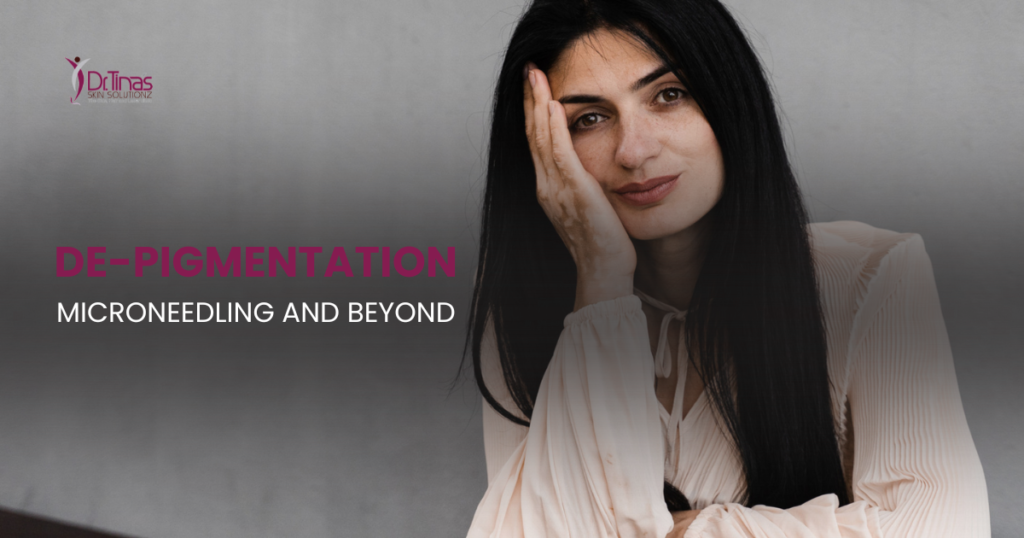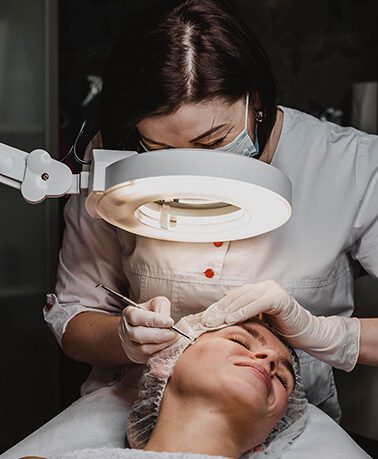Breaking New Ground in De-pigmentation: Microneedling and Beyond

Are you tired of trying endless creams and treatments to tackle stubborn pigmentation?
You’re not alone! Whether it’s sunspots, melasma, or post-inflammatory hyperpigmentation, skin pigmentation can be frustrating. The good news is that there’s a game-changing treatment that’s taking the beauty world by storm: microneedling.
- Really Microneedling for Pigmentation?
- Introducing Microneedling: The Game-Changer
- Micro-Needling Benefits: Why Is It So Effective for Pigmentation?
- Beyond Microneedling: Other Advances in Pigmentation Treatment
- Microneedling Safety: What You Need to Know
- What to Expect During and After Microneedling
Really Microneedling for Pigmentation?
This innovative approach is helping many people like you achieve smoother, more even-toned skin. What exactly is it, and why is it becoming the go-to option for hyperpigmentation treatment?
In this blog, we’ll explore how microneedling works, its benefits, and other exciting advancements in skin pigmentation treatment. So, sit tight as we dive deep into microneedling and beyond!
What Is Hyperpigmentation?
Before jumping into the world of microneedling, let’s get clear on what we’re dealing with. Hyperpigmentation is the darkening of certain areas of the skin, usually caused by excess melanin production. This can be triggered by factors like:
- Sun exposure: The sun’s UV rays can lead to an overproduction of melanin.
- Hormonal changes: Conditions like melasma are often linked to hormonal imbalances.
- Post-inflammatory reactions: Acne scars or skin injuries can leave dark spots behind.
- Aging: As we age, our skin naturally becomes more prone to uneven pigmentation.
So, while hyperpigmentation itself isn’t harmful, it’s an unwanted guest, and finding an effective hyperpigmentation treatment can sometimes feel like a never-ending battle.
Introducing Microneedling: The Game-Changer
Let’s cut to the chase. Microneedling is not just another fad treatment. It’s a revolutionary procedure that offers real results for those dealing with pigmentation issues. If you’re asking, “What exactly is microneedling and why should I consider it for my skin pigmentation treatment?”—here’s a breakdown.
Microneedling, also known as collagen induction therapy, involves using a device that creates tiny, controlled punctures on the surface of your skin.
These micro-injuries trigger your body’s natural healing process, stimulating collagen and elastin production. This healing process can drastically improve your skin’s texture and tone, making microneedling a fantastic hyperpigmentation treatment.
Micro-Needling Benefits: Why Is It So Effective for Pigmentation?
- Stimulates collagen production: Microneedling promotes the production of new collagen, which helps reduce pigmentation by renewing skin cells.
- Faster skin regeneration: The controlled injuries lead to quicker healing and faster skin cell turnover, which means dark spots fade more rapidly.
- Increases product absorption: After a microneedling session, your skin absorbs skincare products more effectively, enhancing the benefits of serums and creams used for pigmentation.
- Minimal downtime: Compared to more invasive procedures, microneedling has a relatively short recovery period, with most people returning to normal activities in 24-48 hours.
- Customizable for different skin types: Microneedling can be adjusted depending on your skin type and the severity of your pigmentation, making it a flexible treatment option.
If you’re someone who’s been endlessly searching for a “micro-needling treatment near me,” now might be the perfect time to give it a shot. But, is microneedling the only option you should consider?
Beyond Microneedling: Other Advances in Pigmentation Treatment
While microneedling is leading the pack in terms of effectiveness, it’s not the only tool in the de-pigmentation toolbox. Other complementary treatments can enhance your results, especially when combined with microneedling.
1. Chemical Peels
Chemical peels involve applying an acid solution to the skin, which exfoliates the outermost layers and helps to reduce pigmentation. When combined with microneedling, chemical peels can offer a more profound impact, giving you clearer, brighter skin.
2. Laser Treatments- CO2 and Q switched ndyag laser
Lasers work by targeting specific pigment cells in the skin and breaking them down. It’s a more intense treatment than microneedling, but for stubborn or deeper pigmentation, laser therapy can work wonders. Some people opt to alternate between microneedling and laser sessions for optimal results.
3. Topical Treatments
If you’re not quite ready for in-office treatments, topical products with ingredients like vitamin C, kojic acid, and retinoids can also help lighten pigmentation.
Though these won’t provide the immediate results that microneedling or lasers might, they are excellent for maintaining your skin post-treatment.
Microneedling Safety: What You Need to Know
Let’s be honest. Any treatment that involves tiny needles might make some people feel squeamish. But don’t worry! Microneedling is safe and effective when performed by trained professionals. Here are a few things to keep in mind:
- Always choose a licensed professional: While at-home microneedling kits are available, getting it done professionally ensures both safety and effectiveness.
- Post-care is important: Your skin will be extra sensitive after a microneedling session, so avoid sun exposure, skip makeup for a day or two, and make sure to use hydrating serums.
- Side effects are minimal: Mild redness and slight swelling are common after treatment, but these usually subside within a few hours to a day.
By choosing a reputable “micro-needling treatment,” you’ll be setting yourself up for a safe and successful experience.
What to Expect During and After Microneedling
If you’ve decided to take the plunge, you’re probably wondering what the procedure feels like and how long it’ll take to see results. Here’s what you can expect:
- During the session, a numbing cream is typically applied to minimize discomfort. The device runs across your skin in steps. which may feel like a mild scratching sensation.
- Immediately after your skin will look slightly red (similar to a mild sunburn), and you might feel a bit of tightness.
- Results timeline: You’ll likely notice improvements in your skin texture and tone after just one session, but for best results, multiple treatments (around 3-6) are recommended, depending on the severity of your pigmentation.
Conclusion: Is Microneedling Right for You?
If you’ve been struggling with uneven skin tone or dark spots, microneedling offers a promising solution. Not only does it tackle pigmentation issues, but it also boosts collagen and promotes healthier skin overall.
And the best part?
It can be easily combined with other treatments for a more comprehensive approach to hyperpigmentation treatment. As with any skin treatment, the key is consistency and choosing the right professionals. If you’ve been searching for “micro-needling treatment” or want to explore options beyond microneedling, consult Dr. Tina’s Skin Solutionz for better results.
Remember, every great journey starts with a single step—or in this case, a tiny needle prick! So why wait?
Your path to glowing, even-toned skin is just a microneedle away.
Treat your hyper pigmentation

Dr.Tina Ramachander is one of the best dermatologist in Bangalore and Medical Director at Dr.Tina’s Skin Solutionz, a skin care clinic in Bangalore. She completed her master’s in dermatology from the well acclaimed JJM Medical college in Karnataka and is now a practicising dermatosurgeon and Medical Cosmetologist in Bangalore.

